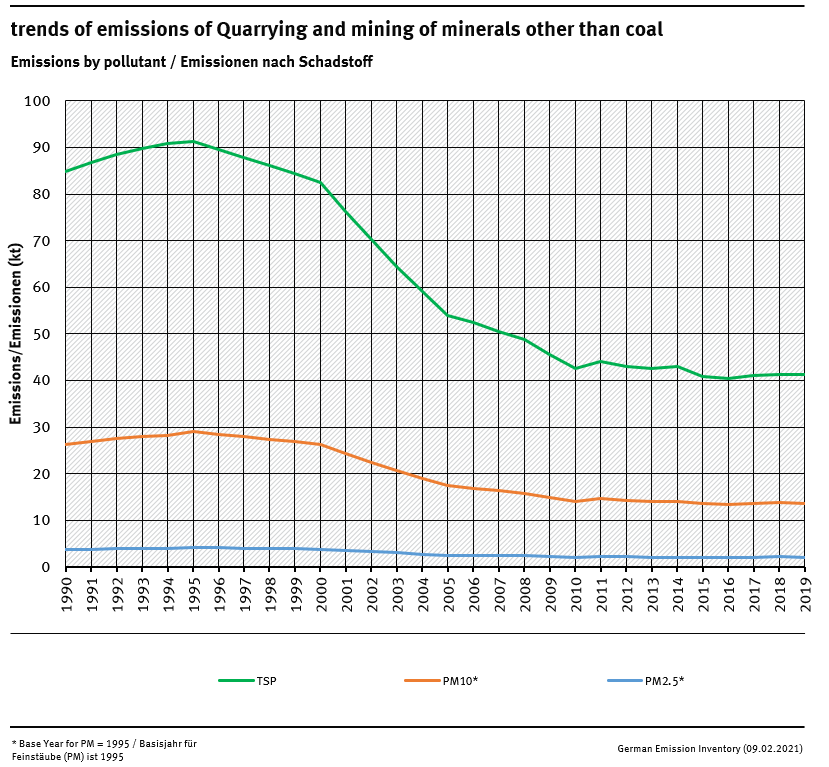meta data for this page
2.A.5.a - Quarrying & Mining - Other Than Coal
| Category Code | Method | AD | EF | ||||||||||||
|---|---|---|---|---|---|---|---|---|---|---|---|---|---|---|---|
| 2.A.5.a | T1 | NS | D | ||||||||||||
| Key Category | SO₂ | NOₓ | NH₃ | NMVOC | CO | BC | Pb | Hg | Cd | Diox | PAH | HCB | TSP | PM₁₀ | PM₂ ₅ |
| 2.A.5.a | - | - | - | - | - | - | - | - | - | - | - | - | L/- | L/T | L/- |
For particulate emissions, Mining is the main emissions source in the Mineral industries.
In Germany we use two approaches - one for Sands and rocks, one for salts.
Short description - Sands and Rocks
The mining process emits relevant amounts of particles. Quarrying and mining of minerals other than coal is subsumed, in particular mining of limestone, hard rock and building Sands, with rising recycled materials.
Methodology
With the use of the 2019 GB method 1), a Tier 2 method is available that can reflect different national conditions. In particular, this concerns input variables on humidity and wind speed, which are differentiated into twelve regions.
Activity Data
As provided for in the GB model, we use AD in the split hard rock, sand and recycled material. These AD are taken from association information because the national statistics are not complete 2). Data gaps are interpolated for time series concsistency. The application of the method therefore resulted in higher AD.
Emission factors
The calculation of emissions takes into account national circumstances and reduction measures.The calculations are available in total more than ten Excel files (individual years since 1990, annually from 2010). Since the GB tool in principle calculates emissions for exactly one year 3), files must be available for exactly those years in which input data are available. Intermediate years are interpolated in case of data gaps.
With the help of the GB tools, IEFs are reported on an annual basis, which are used for the inventory method AR x EF. The emission factors are virtual, but the calculation of this can be modified if further information on the parameters of the GB-tool is available.
Trend discussion
Recalculations
Recalculations were necessary due to minor revised AD for the last recent year.
Planned improvements
At the moment, it is planned to take into account more Country specific conditions and more temporal changes of these.
Short description - Salt Production
Salt production is a sub-category of the mining activities in respect of the country specific approach used. Currently, a Tier 1 method is used: information on production of salts are multiplied with emission factors for TSP and PM.
Method
Activity data
The data from national statistics includes production of potash and rock salt. Potash salt is dominating, nevertheless gaps of statistics are filled and emissions are modelled as potash salt only.
Emission factors
The emission factors are based on analogy to bulk product handling by an expert judgements from UBA:
Table 2: Overview of applied emission factors, in kg/t salt
| Pollutant | EF value | EF trend | |||
|---|---|---|---|---|---|
| TSP | 0.031 | constant | |||
| PM₁₀ | 0.016 | constant | |||
| PM₂.₅ | 0.003 | constant |
Planned improvements
At the moment, no category-specific improvements are planned.


